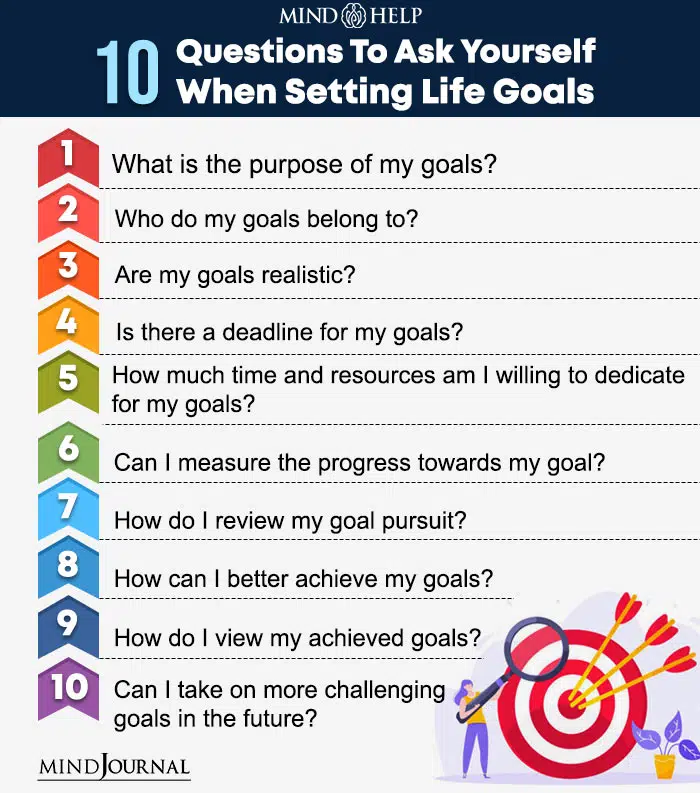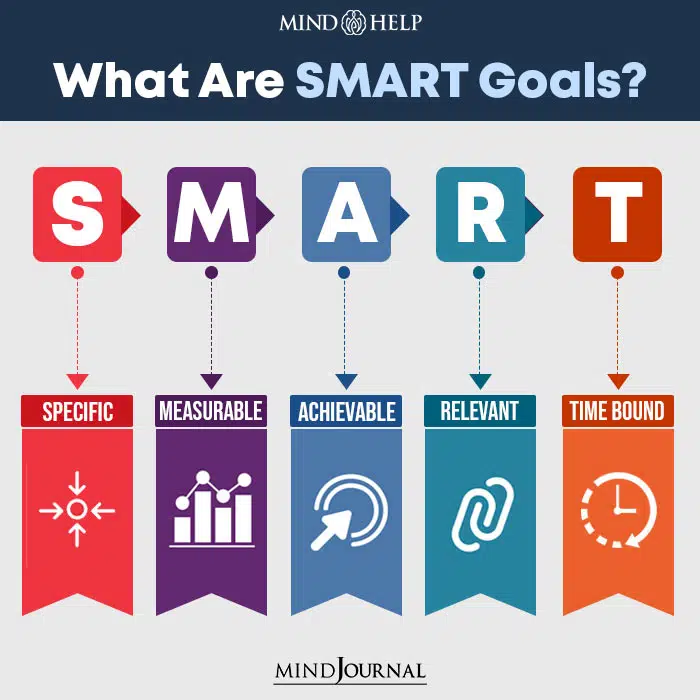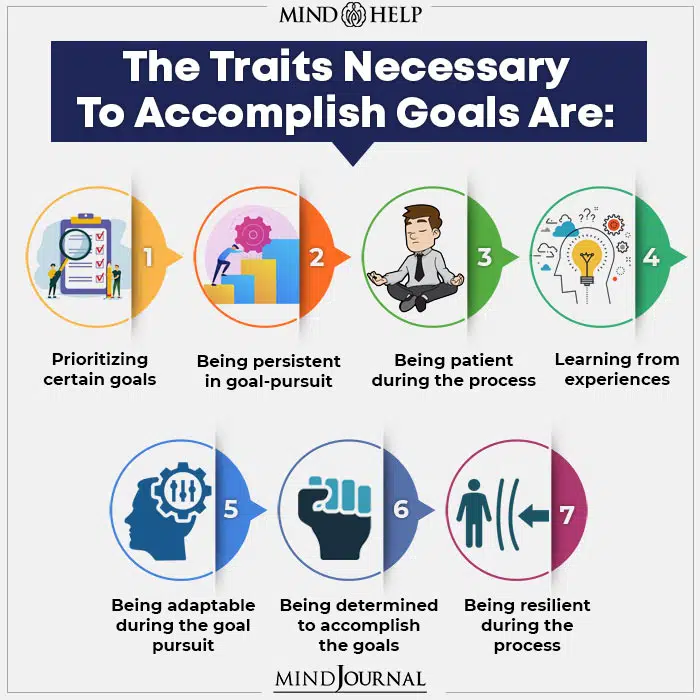To set goals in life is to have a clear sense of your life’s purpose and enjoy a sense of success and fulfillment. Setting goals is a process in which you plan a better future and motivate yourself to turn that vision into reality. The first step that will help us reach our goal is a careful selection of our most important, realistic, and motivating targets.
What Is A Goal?
To understand and ace how to set goals in life, we must first understand “what is a goal?”.
A goal is an aim, ambition, or the desired result that you have to create a better future for yourself. It is very different from a wish, dream, or desire because it involves planned action.
Your goal can be smaller and short-term or complex and long-term, depending on what you want to achieve and how you would like to improve. These are usually related to family, relationships, lifestyle, education, career, business, retirement, or desires like traveling the world.
Our goals come from our identities, habits, and ideas, and, sometimes, we can be overwhelmed by their sheer number throughout our lives. This is why we need to set goals in life. We should always set time-bound, realistic, and motivating objectives so that we can achieve that which is most meaningful in our lives.
What Are The Types Of Goals In Life?
While setting goals in life, people have defined goals in a variety of ways—mostly according to their habits, the time they take to achieve them, or their purpose. According to a 2019 study [mfn] Berkman E. T. (2018). The Neuroscience of Goals and Behavior Change. Consulting psychology journal, 70(1), 28–44. https://doi.org/10.1037/cpb0000094 [/mfn], the way we set goals in life highlights their important aspects and helps us select our targets and change our behavior during the pursuit of the goals.
Goals can be divided into the following categories:
1. Short Term Goals
Short-term goals are the aims that you want to achieve in the near future, in a span of days, weeks, or months. These can be further divided into:
1. Foundational goals
Foundation goals are short-term goals that can be achieved within the span of a year. These can be stand-alone targets or “enabling goals” connected to simple, everyday tasks. Its examples include:
- Saving money to buy an appliance
- Cleaning the house, etc.
2. Provisional goals
Provisional goals are also called “enabling goals” because they are smaller and achievable aims that usually connect to long-term goals. These include:
- Getting better grades in high school to get into college
- Saving up to start a business, etc.
2. Long Term Goals
Long-term goals are elaborate aims for the future. These targets are typically planned many years in advance and are related to:
- Family
- Lifestyle
- Career
- Business
- Retirement
Read More About Family Here
Long-term goals can be further divided into:
1. Capstone goals
These goals are time-consuming but manageable stepping stone objectives that lead to life goals. For instance:
- Going to college is the capstone goal towards your lifetime goal of becoming a teacher.
2. Lifetime goals
Lifetime goals are the major targets that you want to accomplish in your lifetime. These aims are your most meaningful and important goals, and—depending on your age—these can take years to achieve. Setting life goals examples include:
- Buying a retirement home
- Traveling around the world, etc.
What Is Setting Goals In Life?
In the 1960s, American psychologist Edwin Locke [mfn] Stajkovic, A. D., Locke, E. A., & Blair, E. S. (2006). A first examination of the relationships between primed subconscious goals, assigned conscious goals, and task performance. The Journal of applied psychology, 91(5), 1172–1180. https://doi.org/10.1037/0021-9010.91.5.1172 [/mfn] formulated the “Goal Setting Theory of Motivation” [mfn] Locke, E. A. (2015). Theory Building, Replication, and Behavioral Priming: Where Do We Need to Go From Here? Perspectives on Psychological Science, 10(3), 408–414. https://doi.org/10.1177/1745691614567231 [/mfn], linking goal setting to the successful performance of any task. On the basis of Locke’s theory, future goal-setting strategies are developed.
A powerful way in which you can envision a better future and motivate yourself to turn this vision into a future reality is to set goals in life. Usually, it involves the following components:
- A goal, or a desired idea for the future
- A plan, or a map to achieve that goal
- Hard work, or the effort you put into achieving a goal
- Motivation, or the drive to work hard to achieve a goal
- Resilience, or being patient through the process
- Success, or the achieved goal
Goals are essential parts of who we are as people. Too little or too many objectives can deter us from achieving the future we want. On the other hand, successful outcomes of realistic targets help us enjoy a better future and greater wellbeing [mfn] Jennings, E. G., Dunsiger, S. I., Bock, B. C., Hartman, S. J., Williams, D. M., & Marcus, B. H. (2018). Setting larger session duration goals is associated with greater future physical activity. PLOS ONE, 13(12), e0208644. https://doi.org/10.1371/journal.pone.0208644 [/mfn]. So, to set goals in life, it is important that we select the targets that are more achievable and motivating.
According to experts, while setting goals in life, we usually come face to face with two situations [mfn] Liu, W., Zhou, C., Ji, L., & Watson, J. C., 2nd (2012). The Effect of Goal Setting Difficulty on Serving Success in Table Tennis and the Mediating Mechanism of Self-regulation. Journal of human kinetics, 33, 173–185. https://doi.org/10.2478/v10078-012-0056-y [/mfn], namely:
- Goal selection
- Goal competition
Our success in achieving our goals depends on how well we sail through these two factors.
Goal Selection vs Goal Competition

Most of the time, we can be overwhelmed by the sheer number of targets we can create in our lives. These compete with each other for our time and attention and distract us from setting and achieving the targets that matter most to us. Psychology terms this condition as “goal competition” [mfn] Höchli, B., Brügger, A., & Messner, C. (2018). How Focusing on Superordinate Goals Motivates Broad, Long-Term Goal Pursuit: A Theoretical Perspective. Frontiers in psychology, 9, 1879. https://doi.org/10.3389/fpsyg.2018.01879 [/mfn].
In fact, the first step in avoiding goal competition is categorizing the goals. Life coaches stress on the importance of signaling out one specific or a set of aims from a larger heap so that we can put our energy and focus on well-defined goals. This trimming and pruning of goals is called “goal selection” [mfn] Sripada, C., Swain, J. D., Ho, S. S., & Swain, J. E. (2014). Automatic goals and conscious regulation in social cognitive-affective neuroscience. The Behavioral and brain sciences, 37(2), 156–157. https://doi.org/10.1017/S0140525X13002161 [/mfn].
Categorizing our objectives [mfn] van der Hoek, M., Groeneveld, S., & Kuipers, B. (2018). Goal Setting in Teams: Goal Clarity and Team Performance in the Public Sector. Review of Public Personnel Administration, 38(4), 472–493. https://doi.org/10.1177/0734371X16682815 [/mfn] is crucial to our goal pursuit. It joins together multiple, smaller “enabling goals” into a long-term goal in a larger picture, and vice versa. This can actually help us reorganize our priorities and progress more quickly with more motivation and effort.
Especially while achieving life goals—categorizing our long-term goals into smaller, manageable short-term goals helps to combine long-term vision with short-term motivation and successfully fulfill them.
What Is The Importance Of Goal Setting?
Goal setting is usually described as the process in which you select and prioritize specific aims from a heap of goals and focus your hard work on achieving them. It is sometimes a tiresome process because you feel burdened by too many ideas in your head. A 2019 study neatly sums up this dilemma: “Goals are usually things we want but have difficulty achieving even when we know they are achievable.”
Goal setting comes with a number of benefits. These include:
- Putting more focus [mfn] Schippers, M. C., & Ziegler, N. (2019). Life Crafting as a Way to Find Purpose and Meaning in Life. Frontiers in psychology, 10, 2778. https://doi.org/10.3389/fpsyg.2019.02778 [/mfn] on your main objectives
- Measuring readily your progress towards your long-term targets
- Developing a sense of control [mfn] Stock, J., Cervone, D. Proximal goal-setting and self-regulatory processes. Cogn Ther Res 14, 483–498 (1990). https://doi.org/10.1007/BF01172969 [/mfn] and confidence in your life
- Avoiding procrastination and getting you closer to your desired future
- Building behavioral traits necessary to accomplish goals
- Improving your overall task performance in goal-fulfillment
- Getting motivated [mfn] Locke, Edwin & Latham, Gary. (2002). Building a Practically Useful Theory of Goal Setting and Task Motivation: A 35Year Odyssey. American Psychologist – AMER PSYCHOL. 57. 705-717. 10.1037/0003-066X.57.9.705. [/mfn] to tackle more challenging and valuable goals
Steps To Set Goals In Life
Goal setting is something that we recognize as an important parcel of achieving success. But, in order to set targets goal setting is something that we recognize as an important parcel of achieving success. But, in order to set goals in life, you have to understand how to choose a goal, prioritize it, and work towards achieving it.

Experts usually recommend SMART goals [mfn] Mai, C., & Clark, B. (2016). SMART: A Program to Enhance Self-Directed Learning. Journal of graduate medical education, 8(3), 451–452. https://doi.org/10.4300/JGME-D-15-00588.1 [/mfn] when they suggest how to set goals in life. It is an acronym first formulated in 1981 by Peter Drucker in his strategy of Management by Objectives (MBO). It stands for:
- S – Specific
- M – Measurable
- A – Achievable
- R – Relevant
- T – Time-bound
You can explore how to set goals in life and develop and achieve them by using SMART goals, including:
- Setting realistic goals and expectations
- Specifically clarifying the set goals in life
- Choosing time-bound methods that make your relevant objectives simple and achievable
- Understanding how much effort and resources you need to put in order to materialize your targets
- Securing your commitment towards the set goals in life
- Measuring your progress regularly
- Implementing regular feedback into your working process to better your efforts to achieve life goals
- Celebrating the goal-pursuit process
- Getting motivated to take on more complex, more challenging goals in the future.
Strategies To Achieve Goals

Without a doubt, the most important step to set goals in life is executing them and achieving a successful outcome. You may refer to the following ways to reach your life goals:
1. Have SMART Goals
Before you decide to set your life goals, consider formulating SMART goals that are practical, achievable, and time-bound. Research [mfn] Chatterjee, D., & Corral, J. (2017). How to Write Well-Defined Learning Objectives. The journal of education in perioperative medicine : JEPM, 19(4), E610. [/mfn] and select your targets carefully and consider other factors, like the resources you will use, the skills and time needed for the task, etc.
2. Write Down Your Goals
A 2006 study [mfn] Walker S. E. (2006). Journal writing as a teaching technique to promote reflection. Journal of athletic training, 41(2), 216–221. [/mfn] shows that writing increases self-reflection, critical thinking, determination, and clarity of thoughts.
So, consider writing down your goals to make them appear real and tangible. Use journals, planners, sticky notes, goal setting apps and devices [mfn] Baretta, D., Bondaronek, P., Direito, A., & Steca, P. (2019). Implementation of the goal-setting components in popular physical activity apps: Review and content analysis. DIGITAL HEALTH. https://doi.org/10.1177/2055207619862706 [/mfn], etc. write your aims and make them more prominent in your mind.
Read More About Self-Love Here
3. Develop A Plan
Planning goals is a large part of self management strategies [mfn] Lenzen, S. A., Daniëls, R., van Bokhoven, M. A., van der Weijden, T., & Beurskens, A. (2017). Disentangling self-management goal setting and action planning: A scoping review. PloS one, 12(11), e0188822. https://doi.org/10.1371/journal.pone.0188822 [/mfn] that enables you to fulfill your targets. Identify the obstacles and plan your larger aims into smaller, achievable targets using techniques such as “goal pyramids”, checklists, “goal ladders”, etc.
4. Make Your Goals Visible
Before you set goals in life, try aligning your environment to make your aims more visible and achievable. Try visual cues and psychological hacks, like the paper-clip-method or the Seinfeld Strategy, to constantly remind you about your targets and the future you want to achieve.
5. Take Action
Put to action the set goals in life and punctually stick to your planning. Be patient, understanding, and persevering throughout the goal pursuit.
6. Better Your Strategy
Being motivated to fulfill your goal is good, but getting obsessed with them leads to burnout and an unhealthy work-life balance. Keep your perspective throughout the process and be accountable for your actions. Reflect on your progress and readjust your methods to better your effort.
This can help you progress steadily and consistently towards your goal fulfillment.
7. Learn Along The Way
Learn as much as you can during the goal-pursuit process. Celebrate [mfn] Goldman, B. M., Locke, E. A., Masterson, S. S., Groth, M., & Jensen, D. G. (2002). Goal-Directedness and Personal Identity as Correlates of Life Outcomes. Psychological Reports, 91(1), 153–166. https://doi.org/10.2466/pr0.2002.91.1.153 [/mfn] the wins of your short-term objectives, learn along the way [mfn] Epton, T., Currie, S., & Armitage, C. J. (2017). Unique effects of setting goals on behavior change: Systematic review and meta-analysis. Journal of consulting and clinical psychology, 85(12), 1182–1198. https://doi.org/10.1037/ccp0000260 [/mfn], and get motivated by the success of smaller targets to take on more complex and challenging ambitious designs in the future.
Takeaway
The ability to set life goals is a powerful tool that you can use for envisioning a better future. The process you have to go through to set goals in life can be tricky and overwhelming sometimes, but carefully selecting realistic targets and prioritizing them with your hard work can help you achieve success in the long run.
Goals At A Glance
- To set goals in life is to envision and materialize a better future for yourself.
- Setting targets gives you a sense of purpose, self-control, and confidence.
- Goal setting includes selecting and prioritizing certain aims over others.
- It involves setting realistic, time-bound, and achievable goals.
- Setting life goals examples include those related to life, career, education, retirement, etc.
- Setting SMART goals makes goals successful.
Frequently Asked Questions (FAQs)
1. What are the 4 types of goals?
The 4 types of goals are provisional goals, short-term goals, long-term goals, and lifetime goals.
2. What are some teenage goals?
Teenagers should set specific and realistic aims related to their life, education, and social relationships. These may include goals to improve their grades, social and communication skills, values, physical and mental health, etc.
3. What is a short-term goal?
A short-term goal is a small goal that you want to achieve very soon, in the near future. The near future can mean a day, a week, a month, or even a year.
4. What is a long-term goal?
A long-term goal is a complex goal that you would like to achieve many years from now. It is usually related to family, career, retirement, etc.
5. Why is it important to set realistic goals?
It is important to set realistic goals because such goals are easily achievable and motivating. They maximize our resources, time, and chances of success.
6. How does setting goals lead to success?
Setting goals helps trigger new habits, maintain focus, and sustain the purpose of life. Successful aims give us a sense of self-mastery and confidence and help us improve our all-around performance and well-being.
7. How do you overcome obstacles in achieving goals?
Identify the potential obstacles, the time, and the resources required for achieving a goal. Make a plan, break down your long-term objectives into short-term targets, and dedicate yourself to your purpose. Be motivated and dedicated toward your set goals in life.
8. How can teachers help students achieve their goals?
When it comes to achieving academic goals, teachers can help students in formulating effective learning and test-taking strategies, and developing useful skills like researching and critical thinking.










Leave a Reply